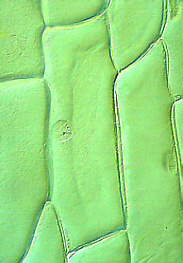
In 1838, M. SCHLEIDEN postulated the cell theory, which states that every plant is organized from cells.In 1839, T. SCHWANN showed that it applies to animals as well and in 1855 VIRCHOW coined the phrase:
, i.e. latin for "each cell stems from another cell". The sentence is of universal validity and is among the few dogmata of biology. The German botanist H. v. MOHL was the first to observe the propagation of plant cells by division in 1835. Around the middle of the 19th century, the cellular organization of plant tissues was mostly outlined. The growing perfection of microscope construction and use, of cutting and conservation techniques as well as the use of selective dyes allowed the reproducible depiction of vegetable cells and tissues. Illustrated textbooks were published. J. v. SACHS' textbook "Lehrbuch der Botanik" (A Textbook on Botany; first edition published in 1868) and its sequel "Vorlesungen über Pflanzenphysiologie" (Lectures on Plant Physiology) were outstanding and pointing the way. Illustrations derived from it were - often simplified - adopted by many following textbooks, thus proving the fact that well-done scientific experiments form the basis on which the following research is founded.
Since these times, microscopic courses belong to the repertoire of basic botanical teaching. A reference textbook, that is still valid today is E. STRASBURGER's "Kleines Botanisches Praktikum" (A Short Botanical Course; first edition published in 1884).
The examinations of the 19th century were mostly restricted to the observation and interpretation of longitudinal and cross-sections through different plant organs. In the 20th century it was concentrated more on problems of the development of special tissues in the course of ontogenesis and evolution (phylogenesis). It was and is tried to understand the plant body as a three-dimensional structure, and to get an idea of the meaning of the spatial arrangements of single tissues towards each other.
Cells come in a large variety of forms. There is no such thing as a typical plant cell. The typical plant cell given in some textbooks displays a compendium of features of different cell types. All cells do, nevertheless, share a number of features, while some are typical only for plant cells. A third group of features distinguishes undifferentiated from differentiated cells.
Every cell is surrounded by a membrane. Both animal and plant cells contain a nucleus that is missing in bacteria and blue green algae. It is thus distinguished between eucaryotes (organisms that have a nucleus) and procaryotes (organisms without a nucleus). Contrary to animal cells plant cells are almost always surround by a cell wall and many of them contain a special group of organelles: the plastids, of which the chloroplasts are the most striking organelles. Cell walls can also be found with bacteria and blue green algae, though neither their chemical structure nor their synthesis is the same as that of plants. It does seem to be an analogous feature, i.e. a structure with the same function, which did not derive from a common earlier stage.
The content of a plant cell (the protoplasm) changes in composition in the course of growth and development. Differentiated cells are marked by a voluminous vacuole.
Besides the clearly visible structures like cell nucleus and chloroplasts, a lot of other granular particles can be seen through a light microscope, some of which can be dyed selectively. Sometimes, different shapes (long, round, etc.) can be distinguished. The majority of these particles has a size that is at or below the power of resolution of a conventional light microscope and their identification was impossible before the use of the electron microscope. Mitochondria are a typical example.
The organelles may contain inclusions like crystals, fat droplets, starch grains or others, a feature that is especially common in specialized cells.
Cells are no static objects. Very often, plasma currents occur that can be detected by the movements of organelles like chloroplasts or different granules. Most of these movements have a direction and sometimes it even looks as if single particles would move along rails. I will show later that molecular evidence for the truth of this impression exists.
|
|